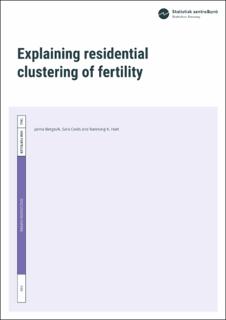| dc.contributor.author | Bergsvik, Janna | |
| dc.contributor.author | Cools, Sara | |
| dc.contributor.author | Hart, Rannveig Kaldager | |
| dc.date.accessioned | 2020-10-23T06:27:38Z | |
| dc.date.available | 2020-10-23T06:27:38Z | |
| dc.date.issued | 2020-10 | |
| dc.identifier.issn | 1892-753X | |
| dc.identifier.uri | https://hdl.handle.net/11250/2684634 | |
| dc.description.abstract | Numerous studies have shown that fertility behavior is spatially clustered. In addition to pure context effects, two causal mechanisms could drive this pattern. First, neighbors may influence each other’s fertility behavior, and second, household fertility intentions and behavior may influence residential decisions. This study provides an empirical examination of these two potential causal mechanisms using the sex composition of the two firstborn children and twin births as instrumental variables (IVs) for having a third child. We measure effects of the third child on three separate outcomes: mothers’ propensity to move, characteristics of their final neighborhood, and the fertility of their neighbors. Residential and childbearing histories for the years 2000-2018 are drawn from Norwegian administrative registers (N ~ 167,000 women). Individual neighborhoods are defined using timevarying geo-coordinates on place of residence. We identify selective moves as one plausible causal driver of the residential clustering of fertility. The effects are relatively small, though statistically significant. This suggests that the residential clustering of fertility is also driven by factors that we effectively control for in our design – most importantly self-selection based on preferences for a family-oriented life style. Because of the difficulty to measure social interaction effects among neighbors we are reluctant to say that they do not exist, even though we do not identify them. As such, we contribute to the understanding of fertility and relocation, but also to the literature on social interaction effects in fertility by testing the relevance of yet another network, i.e. that of neighbors. | en_US |
| dc.language.iso | eng | en_US |
| dc.publisher | Statistisk sentralbyrå | en_US |
| dc.relation.ispartofseries | Discussion Paper;No. 939 | |
| dc.rights | Navngivelse-DelPåSammeVilkår 4.0 Internasjonal | * |
| dc.rights.uri | http://creativecommons.org/licenses/by-sa/4.0/deed.no | * |
| dc.subject | IV estimation | en_US |
| dc.subject | spatial fertility | en_US |
| dc.subject | k-nearest neighbors | en_US |
| dc.subject | family size | en_US |
| dc.subject | third births | en_US |
| dc.title | Explaining residential clustering of fertility | en_US |
| dc.type | Working paper | en_US |
| dc.subject.nsi | VDP::Samfunnsvitenskap: 200::Demografi: 300 | en_US |
| dc.source.pagenumber | 30 | en_US |
| dc.relation.project | Norges Forskningsråd: 262700 | en_US |
| dc.relation.project | Norges Forskningsråd: 236926 | en_US |

